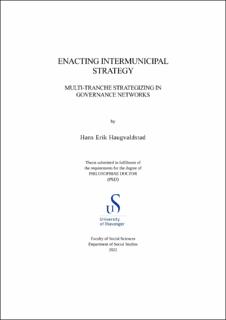| dc.description.abstract | Entering into interorganizational collaborations is one approach to handling the complex challenges faced by the public sector (Eriksson et al., 2020; Poister et al., 2013; Roberts, 2000; Torfing, 2019). Such collaborations often take the form of governance networks (Torfing, 2012). While attention has been paid to aspects such as network governance (Klijn, 2008; Sørensen & Torfing, 2017, 2009), structure, management (Provan & Kenis, 2008), democratic legitimacy (Klijn & Skelcher, 2007; Sørensen & Torfing, 2005), and efficiency (Provan & Kenis, 2008; Wang, 2016), little has been written on how the participants in a governance network conduct strategic work. Therefore, this thesis aims to explore how strategy is conceptualized and enacted within the context of municipal governance networks.
This study leans on the strategy-as-practice (SAP) perspective (Golsorkhi et al., 2015; Jarzabkowski et al., 2016; Reckwitz, 2002; Whittington, 1996) to explore the empirical context of a governance network (Torfing, 2012) tasked with helping the participating municipalities with digital transformation. Within the SAP perspective, strategy refers to the consequential activities performed to move an organization in a certain direction, whereas strategizing refers to how these activities are produced (Golsorkhi et al., 2015; Jarzabkowski et al., 2007; Jarzabkowski et al., 2021; Jarzabkowski & Spee, 2009). In addition, the concepts of open strategy (Hautz et al., 2017; Seidl et al., 2019; Whittington et al., 2011) and interorganizational strategizing (De Gooyert et al., 2019) are used to inform the strategy work conducted, augmented by literature on organizational motivations (De Gooyert et al., 2019; Hautz et al., 2019; Seidl et al., 2019), the enticement of individuals (Brabham, 2010; Dahlander et al., 2019; Dahlander & Piezunka, 2014; Seltzer & Mahmoudi, 2013), democratic legitimacy (Mosley & Wong, 2020; Papadopoulos & Warin, 2007; Scharpf, 1999; Schmidt, 2012), organizational legitimacy (Deephouse et al., 2017; Suchman, 1995), and strategy implementation (Friesl et al., 2020; Weiser et al., 2020) to discern empirical nuances.
A pragmatic research paradigm (Kaushik & Walsh, 2019; Morgan, 2014; Pansiri, 2005; Powell, 2001) is adopted in an effort to identify real-world challenges faced when enacting strategy in a governance network, as identified – either directly or indirectly – by the stakeholders themselves. A case study with an abductive approach (Blaikie, 2009; Dubois & Gadde, 2002; Gerring, 2004; Yin, 2003) is conducted on the governance network Digi Rogaland. Additionally, data are collected from three of the participating municipalities to explore how they relate to the network and work to enact the network strategy. Qualitative methods are used, and the empirical material consists of interviews, observations, and documents. Analysis is conducted through a reflexive process (Alvesson & Sköldberg, 2018; Alvesson & Kärreman, 2007).
The findings first identify a desire and need to entice municipalities to participate in interorganizational strategizing (Article 1). This is achieved using financial, structural, and nonfinancial mechanisms to promote adherence and lock the participants into the network, thus allowing for standardizations across municipal borders. Second, the analysis identifies a legitimacy gap between stakeholders directly involved in the network and those only indirectly affected (Article 2). Directly involved stakeholders view the network as a necessity, whereas indirectly affected stakeholders are mainly indifferent or, in some cases, opposed to participation. Third, challenges in enacting a network strategy are identified, which require balancing acts (Article 3). These are ambiguously balanced against clarity in strategy conceptualization, the use of coercion against voluntary participation, the choice of concentrating or distributing decision-making power, and the selection of a top-down or bottom-up approach to coordination.
The overarching analysis reveals that, when viewed from the SAP perspective, the network strategy is not enacted in the sense that no consequential activities for moving in the strategic direction of the network can be identified within the municipalities. This study finds that strategizing mainly occurs within the network, while strategizing to bridge between the network and municipalities is left to the municipalities themselves. However, this strategizing is not achieved. Possible explanations include a lack of legitimacy, limited inclusion and transparency with a top-down perspective on strategy, and different organizational interests and capabilities.
This thesis contributes to theoretical and empirical knowledge by identifying strategic practices with a top-down perspective – an approach that does not conform with the ideals of openness and collaboration in governance networks. The analysis indicates the need to engage in multi-tranche strategizing in order to enact strategy in the participating municipal organizations. To sufficiently enact a strategy, strategizing is necessary not only in the network and municipal tranches but also in the interplay between these sets of stakeholders. Furthermore, the analysis identifies differences in underlying assumptions in the applied theoretical frameworks, including differences in legitimacy, participation, and transparency. Suggested avenues of future research include empirical studies of open strategy principles applied in public organizations, such as the selection of participants, the distribution of decision-making power, and the dissemination of information. | en_US |

